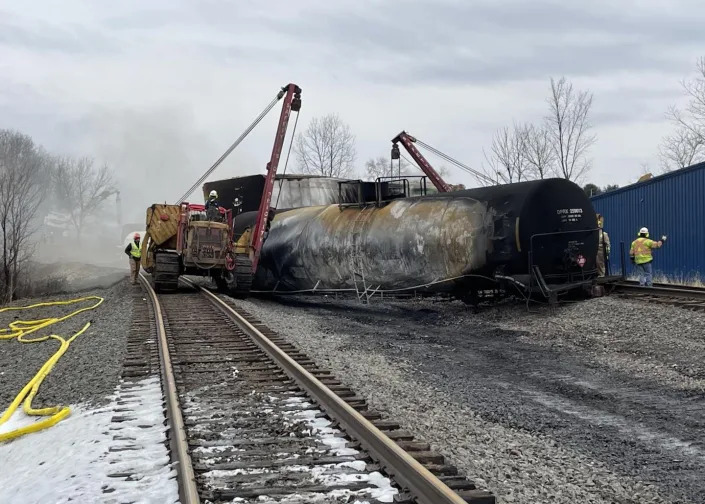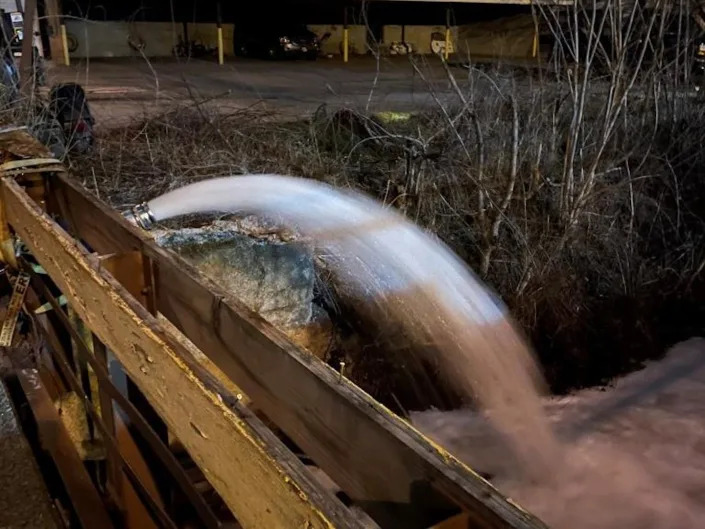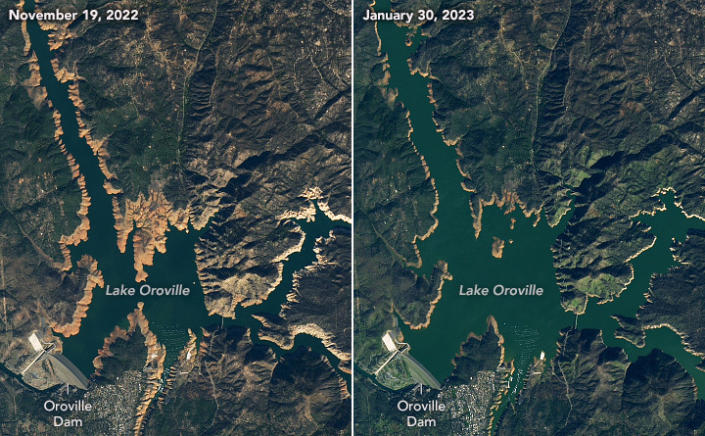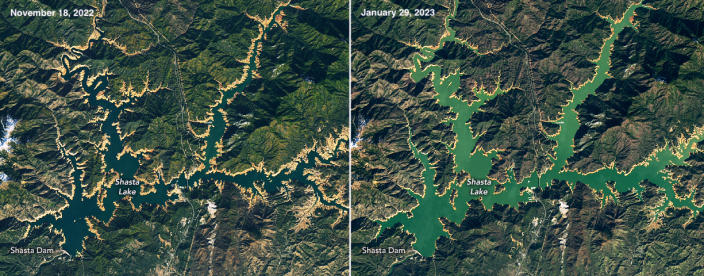The New York Times
For the First Time, Genetically Modified Trees Have Been Planted in a U.S. Forest
Gabriel Popkin – February 17, 2023

On Monday, in a low-lying tract of southern Georgia’s pine belt, a half-dozen workers planted row upon row of twig-like poplar trees.
These weren’t just any trees, though: Some of the seedlings being nestled into the soggy soil had been genetically engineered to grow wood at turbocharged rates while slurping up carbon dioxide from the air.
The poplars may be the first genetically modified trees planted in the United States outside of a research trial or a commercial fruit orchard. Just as the introduction of the Flavr Savr tomato in 1994 introduced a new industry of genetically modified food crops, the tree planters Monday hope to transform forestry.
Living Carbon, a San Francisco-based biotechnology company that produced the poplars, intends for its trees to be a large-scale solution to climate change.
“We’ve had people tell us it’s impossible,” Maddie Hall, the company’s co-founder and CEO, said of her dream to deploy genetic engineering on behalf of the climate. But she and her colleagues have also found believers — enough to invest $36 million in the 4-year-old company.
The company has also attracted critics. The Global Justice Ecology Project, an environmental group, has called the company’s trees “growing threats” to forests and expressed alarm that the federal government allowed them to evade regulation, opening the door to commercial plantings much sooner than is typical for engineered plants.
Living Carbon has yet to publish peer-reviewed papers; its only publicly reported results come from a greenhouse trial that lasted just a few months. These data have some experts intrigued but stopping well short of a full endorsement.
“They have some encouraging results,” said Donald Ort, a University of Illinois geneticist whose plant experiments helped inspire Living Carbon’s technology. But he added that the notion that greenhouse results will translate to success in the real world is “not a slam dunk.”
🌳🌳
Living Carbon’s poplars start their lives in a lab in Hayward, California. There, biologists tinker with how the trees conduct photosynthesis, the series of chemical reactions plants use to weave sunlight, water and carbon dioxide into sugars and starches. In doing so, they follow a precedent set by evolution: Several times over Earth’s long history, improvements in photosynthesis have enabled plants to ingest enough carbon dioxide to cool the planet substantially.
While photosynthesis has profound impacts on the Earth, as a chemical process it is far from perfect. Numerous inefficiencies prevent plants from capturing and storing more than a small fraction of the solar energy that falls onto their leaves. Those inefficiencies, among other factors, limit how fast trees and other plants grow, and how much carbon dioxide they soak up.
Scientists have spent decades trying to take over where evolution left off. In 2019, Ort and his colleagues announced that they had genetically hacked tobacco plants to photosynthesize more efficiently. Normally, photosynthesis produces a toxic byproduct that a plant must dispose of, wasting energy. The Illinois researchers added genes from pumpkins and green algae to induce tobacco seedlings to instead recycle the toxins into more sugars, producing plants that grew nearly 40% larger.
That same year, Hall, who had been working for Silicon Valley ventures like OpenAI (which was responsible for the language model ChatGPT), met her future co-founder Patrick Mellor at a climate tech conference. Mellor was researching whether trees could be engineered to produce decay-resistant wood.
With money raised from venture capital firms and Hall’s tech-world contacts, including OpenAI CEO Sam Altman, she and Mellor started Living Carbon in a bid to juice up trees to fight climate change. “There were so few companies that were looking at large-scale carbon removal in a way that married frontier science and large-scale commercial deployment,” Hall said.
They recruited Yumin Tao, a synthetic biologist who had previously worked at the chemical company DuPont. He and others retooled Ort’s genetic hack for poplar trees. Living Carbon then produced engineered poplar clones and grew them in pots. Last year, the company reported in a paper that has yet to be peer reviewed that its tweaked poplars grew more than 50% faster than non-modified ones over five months in the greenhouse.
The company’s researchers created the greenhouse-tested trees using a bacterium that splices foreign DNA into another organism’s genome. But for the trees they planted in Georgia, they turned to an older and cruder technique known as the gene gun method, which essentially blasts foreign genes into the trees’ chromosomes.
In a field accustomed to glacial progress and heavy regulation, Living Carbon has moved fast and freely. The gene gun-modified poplars avoided a set of federal regulations of genetically modified organisms that can stall biotech projects for years. (Those regulations have since been revised.) By contrast, a team of scientists who genetically engineered a blight-resistant chestnut tree using the same bacterium method employed earlier by Living Carbon have been awaiting a decision since 2020. An engineered apple grown on a small scale in Washington state took several years to be approved.
“You could say the old rule was sort of leaky,” said Bill Doley, a consultant who helped manage the Agriculture Department’s genetically modified organism regulation process until 2022.
On Monday, on the land of Vince Stanley, a seventh-generation farmer who manages more than 25,000 forested acres in Georgia’s pine belt, mattock-swinging workers carrying backpacks of seedlings planted nearly 5,000 modified poplars. The tweaked poplars had names like Kookaburra and Baboon, which indicated which “parent” tree they were cloned from, and were interspersed with a roughly equal number of unmodified trees. By the end of the unseasonably warm day, the workers were drenched in sweat and the planting plots were dotted with pencil-thin seedlings and colored marker flags poking from the mud.
In contrast to fast-growing pines, hardwoods that grow in bottomlands like these produce wood so slowly that a landowner might get only one harvest in a lifetime, Stanley said. He hopes Living Carbon’s “elite seedlings” will allow him to grow bottomland trees and make money faster. “We’re taking a timber rotation of 50 to 60 years and we’re cutting that in half,” he said. “It’s totally a win-win.”
Forest geneticists were less sanguine about Living Carbon’s trees. Researchers typically assess trees in confined field trials before moving to large-scale plantings, said Andrew Newhouse, who directs the engineered chestnut project at SUNY College of Environmental Science and Forestry. “Their claims seem bold based on very limited real-world data,” he said.
Steve Strauss, a geneticist at Oregon State University, agreed with the need to see field data. “My experience over the years is that the greenhouse means almost nothing” about the outdoor prospects of trees whose physiology has been modified, he said. “Venture capitalists may not know that.”
Strauss, who previously served on Living Carbon’s advisory board, has grown some of the company’s seedlings since last year as part of a field trial funded by the company. He said the trees were growing well, but it was still too early to tell whether they were outpacing unmodified trees.
Even if they do, Living Carbon will face other challenges unrelated to biology. While outright destruction of genetically engineered trees has dwindled thanks in part to tougher enforcement of laws against acts of ecoterrorism, the trees still prompt unease in the forestry and environmental worlds. Major organizations that certify sustainable forests ban engineered trees from forests that get their approval; some also prohibit member companies from planting engineered trees anywhere. To date, the only country where large numbers of genetically engineered trees are known to have been planted is China.
The U.S. Forest Service, which plants large numbers of trees every year, has said little about whether it would use engineered trees. To be considered for planting in national forests, which make up nearly one-fifth of U.S. forestland, Living Carbon’s trees would need to align with existing management plans that typically prioritize forest health and diversity over reducing the amount of atmospheric carbon, said Dana Nelson, a geneticist with the service. “I find it hard to imagine that it would be a good fit on a national forest,” Nelson said.
Living Carbon is focusing for now on private land, where it will face fewer hurdles. Later this spring it will plant poplars on abandoned coal mines in Pennsylvania. By next year Hall and Mellor hope to be putting millions of trees in the ground.
🌳🌳🌳
To produce an income stream not reliant on venture capital, the company has started marketing credits based on carbon its trees will soak up. But carbon credits have come under fire lately and the future of that industry is in doubt.
And to head off environmental concerns, Living Carbon’s modified poplar trees are all female, so they won’t produce pollen. While they could be pollinated by wild trees and produce seeds, Mellor says they’re unlikely to spread into the wild because they don’t breed with the most common poplar species in the Southeast.
They’re also being planted alongside native trees like sweet gum, tulip trees and bald cypress, to avoid genetically identical stands of trees known as monocultures; non-engineered poplars are being planted as experimental controls. Hall and Mellor describe their plantings as both pilot projects and research trials. Company scientists will monitor tree growth and survival.
Such measures are unlikely to assuage opponents of genetically modified organisms. Last spring, the Global Justice Ecology Project argued that Living Carbon’s trees could harm the climate by “interfering with efforts to protect and regenerate forests.”
“I’m very shocked that they’re moving so fast” to plant large numbers of modified trees in the wild, said Anne Petermann, the organization’s executive director. The potential risks to the greater ecosystem needed to be better understood, she said.
Ort of the University of Illinois dismissed such environmental concerns. But he said investors were taking a big chance on a tree that might not meet its creators’ expectations.
“It’s not unexciting,” he said. “I just think it’s uber high risk.”














